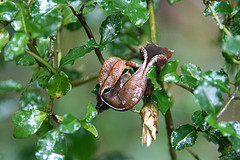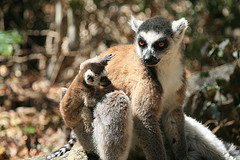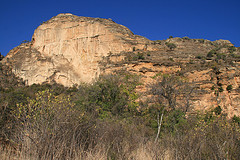Eastern Madagascar: Lemurs, Islands and Lemur Islands
Monday, September 27th, 2010With the southern highlands ‘completed’ earlier than expected thanks to us having the luxury of a private vehicle, we decided to head to eastern Madagascar for our final days in this fabulous country.
Since Knelis and Patricia had not been to Andasibe, we stopped there for two nights, and even though Wendy and I had been there before, we still found some interesting things to do. The highlight was undoubtedly the ‘Ile des Lémuriens’, a small, private island owned by Andasibe’s most luxurious hotel, the Vakôna Lodge. Lemurs previously kept as pets have been relocated to the island, where they are essentially captive (since lemurs can’t swim) but there isn’t a cage in sight and they bound from tree to tree just as they would in the wild. They are incredibly tame these days – apparently it took four years for them to stop being scared of human visitors – and the brown lemurs playfully jumped on our shoulders, and took a particular liking to Wendy just as Indonesian orang-utans did many years ago. We also saw two species here that we hadn’t seen before: the black-and-white ruffed lemur, with a face like a dog; and the small grey bamboo lemur that completes our ‘set’ of the four types of bamboo lemurs. But most handsome of all was the yellow diademed sifaka, and even though we saw this species in the wild on our first trip to Andasibe, it was fabulous to see this one so close and so animated.
The second thing we chose to do at Andasibe was ‘Mad Arbe’, in which, using a harness and a rope ladder, you climb to the top of a 20-metre high tree in the Mitsinjo reserve and look out over the jungle canopy below you. The climb up was harder than we’d anticipated, and my complete lack of upper body strength meant my shoulders and forearms hurt for days afterwards, but the view from the comfort of a hammock tied to the tree-top, and the beautiful calls of nearby troupes of Indri Indri, made it worth the effort.
Continuing east to the coast, we stopped at Parc Ivoloina, a research/tourist site containing five species of free-ranging lemurs and numerous more caged ones. Among the free-ranging lemurs, we saw the crowned lemur at very close range and the white-fronted brown lemur performing enormous leaps at a distance, thus completing our lemur species count – for this trip anyway – at 14 wild species and four more contained but free-ranging ones.
Our final stop, and the purpose of this eastern swing, was Ile Sainte Marie, an idyllic, elongated island in the Indian Ocean, an hour by speed boat from the mainland. Once we arrived, we headed for the southern end of the island and took a wonderful trip in a dugout canoe to an even smaller island called Ile aux Nattes, where we celebrated our new-found mid-range status by lazing in a lovely bungalow and eating lots of seafood while gazing out over the crystal clear waters and palm-fringed coast of the tiny island. Plus, there were some free-ranging black-and-white ruffed lemurs at our resort to complete the Madagascar version of an island getaway.
It is perhaps ironic that our last days as vagabond travellers were spent at the beach, which we’ve essentially avoided for the past eight years, but after two months in East Africa and one in Madagascar, we figured we deserved it, and it was certainly a nice way to finish the trip.
We’re now back in the capital Tana, from where we fly back to Nairobi tomorrow for a couple of days before returning to Geneva.



